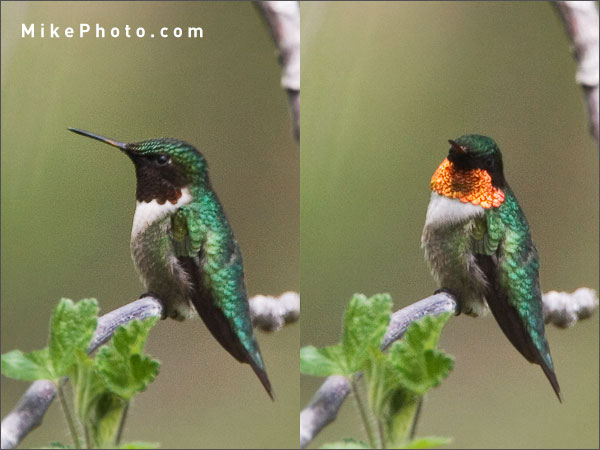Iridescent colours of the Ruby-Throated Hummingbird
The Hummingbird’s feathers are fairly sophisticated. I got interested in learning more about these tiny birds a few years ago while shooting the fall migration at
Holiday Beach. Studying their photographs at a higher magnification I noted that the same bird displayed different colours depending on the angle and intensity of the light. After reading a few papers on the iridescent colours of Hummingbird feathers, and others on “diffraction shading models for iridescent surfaces”, and lastly the book “Hummingbirds of North America” by Paul Johnsgard (link below), I'm closer to understanding the complex feather structures that give out the striking colours of the Hummingbird.
It’s not pigments that give the feather colours; it is the refracted light falling at certain angles upon hummingbird’s gorget – its throat area.
Let’s take a look at the following photograph of an adult male Ruby-Throated Hummingbird observed during spring migration in Point Pelee. It is actually a composite of two photographs taken in rapid succession of each other. The frame on the left has the bird looking straight ahead with the gorget dark and dull. The frame on the right has the bird turning its head towards my camera with the gorget in full brilliant colours. Note that the ambient light is the same in both photographs. And, no flash has been used in either one.
(The brown spot on its beak is probably flower pollen. They are actually excellent pollinators – in Portugese, the word hummingbird means "flower kisser".)

Comparative photograph of the Ruby-Throated Hummingbird iridescent colours
The iridescent feathers of the Hummingbird are structured in a layered format. Only the outward parts of these feathers are actually iridescent. Iridescence is an optical phenomenon of surfaces in which hue changes in correspondence with the angle from which a surface is viewed (Wikipedia). The iridescent feathers actually consist of many tiny sub-feathers called barbs, which in turn consist of another set of tiny sub-feathers called barbules. These barbules have a mosaic of platelets (cells in elliptical form), each measuring two and-a-half microns long and one micron wide (Greenewalt et al. 1960:253). These microstructures of platelets produce the interference colours that are visible as light strikes the hummingbird at different angles.
Interested in learning more? Below you can find links to more information on the iridescence of Hummingbird feathers.